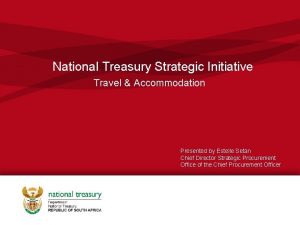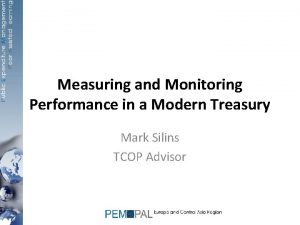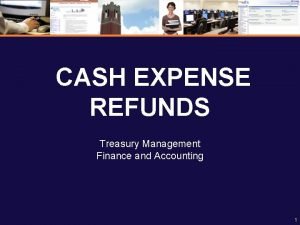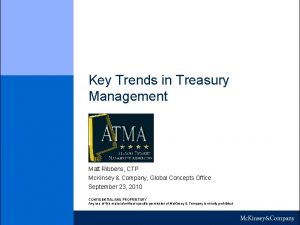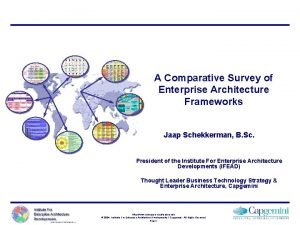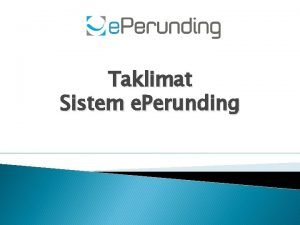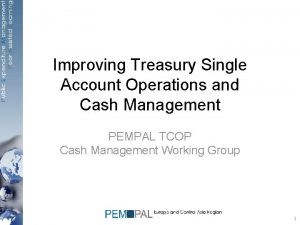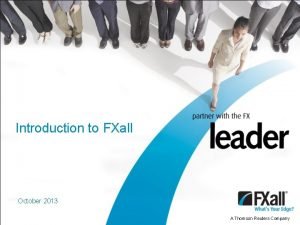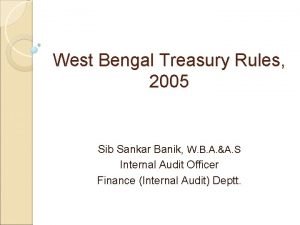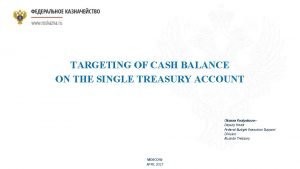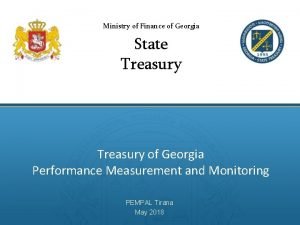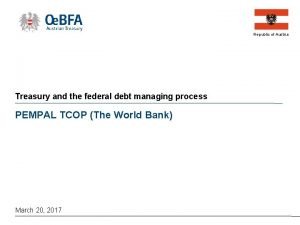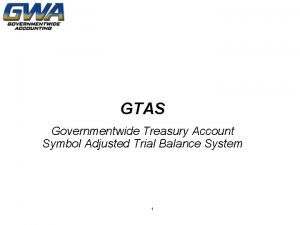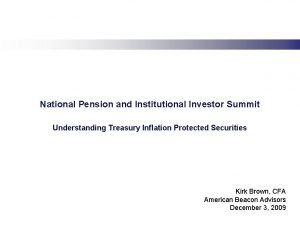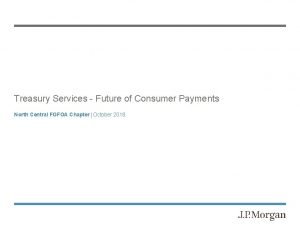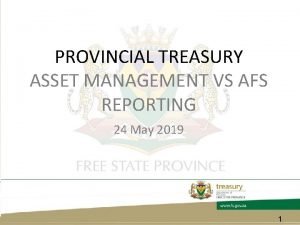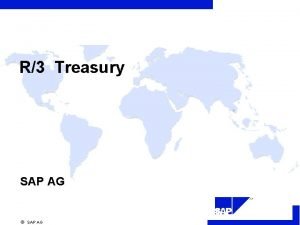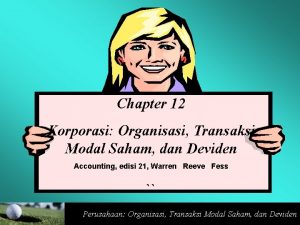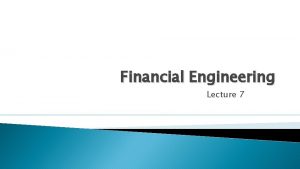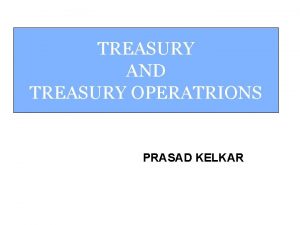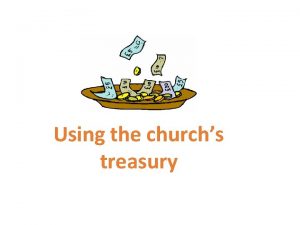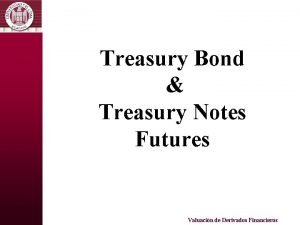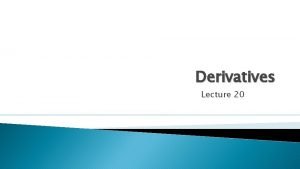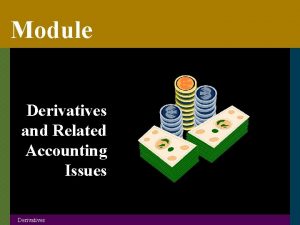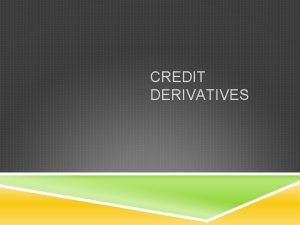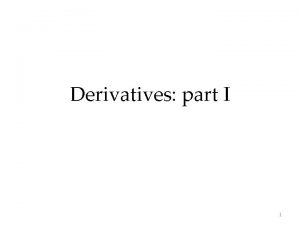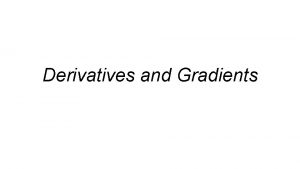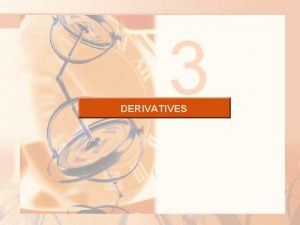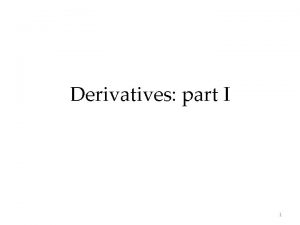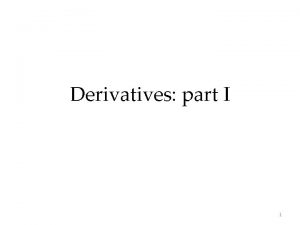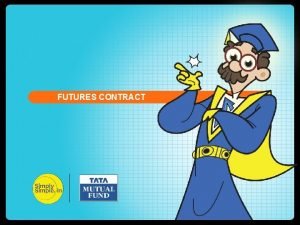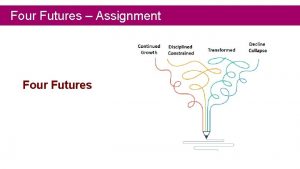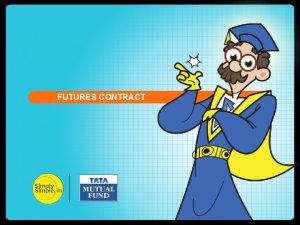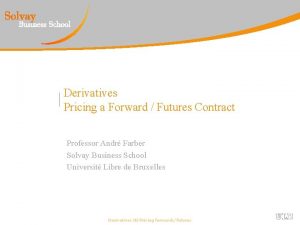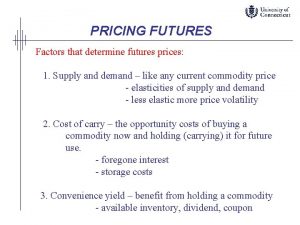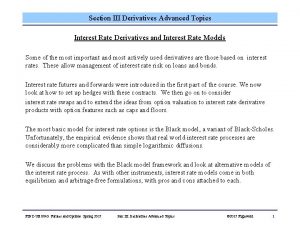Derivatives Lecture 11 Treasury Futures Topics Pricing Delivery




























- Slides: 28

Derivatives Lecture 11

Treasury Futures Topics Pricing Delivery Complications for both Multiple assets can be delivered on the same contract…unlike commodities The deliverable assets all have different prices

Treasury Futures Specs Copyright: CME Group 2019

Treasury Futures Pricing Cheapest to Delivery = Treasury futures allow the short position to select which bond to deliver (or sell) to the long futures position. The short will deliver the bond which is the least costly for the short position to purchase. This occurs since only 4 contracts are used to hedge all interest rate instruments. Thus, a real underlying asset does not exist. Certain bonds are “eligible” for delivery

Cheapest to Deliver Copyright: Bloomberg Financial Services 2015

Cheapest to Deliver Copyright: Bloomberg Financial Services 2015

Cheapest to Deliver Copyright: Bloomberg Financial Services 2015

Cheapest to Deliver Copyright: Bloomberg Financial Services 2015

Cheapest to Deliver Conversion Factor Bond prices vary for many reasons ◦ ◦ Higher coupons have higher prices Lower coupons have lower prices Longer maturities have higher prices Shorter maturities have lower prices If you deliver a more expensive bond, the amount you receive at delivery goes up If you deliver cheap bond, the amount you receive at delivery goes down

Cheapest to Deliver Quoted price = Price of the bond as quoted in the paper Accrued interest = amount of coupon earned on a bond since the last coupon payment Bond Cash Price = (Quoted price of bond X notational amount) + accrued interest Invoice Amount = Amount of money that is exchanged when a futures contract bond is delivered

Accrued Interest

Bond Price & Accrued Interest Example What is the cash price of a bond that pays a 4% semiannual coupon and matures in 12 years and three months, if the YTM is 6. 5%? Price FV = 1000 Pmt = 20 int = 3. 25 n = 24. 50 Solve for PV = $781. 20 Quoted Price = 78. 12

Bond Price & Accrued Interest Example (continued) What is the cash price of a bond that pays a 4% semiannual coupon and matures in 12 years and three months, if the YTM is 6. 5%? Accrued Interest Bond Cash Price

Treasury Futures Pricing Conversion Factor Since the bond we deliver is not specified in the futures contract, the price of the bond must be standardized. The conversion factor converts the futures price into a settlement or invoice price. The conversion factor is the present value of $1 at YTM=6%, assuming coupons are paid semiannual. Repo Rate Difference between the conversion factor yield of 6% and the coupon on the bond.

Conversion Factor Used to convert futures prices to bond prices What is the cash price of a bond that pays a 4% semiannual coupon and matures in 12 years and three months, if the YTM is 6. 5%? Using exact dates on a HP 12 c provides 82. 824

Futures “Cash Price” Also called the Adjusted Futures price Cash Price = Futures Price x Conversion Factor Futures Price = Cash Price / Conversion Factor

Invoice Amount (also called Delivery Cost) Invoice Amount = Futures Price x Conversion factor x Contract Size + accrued Interest Total amount of money exchanged at delivery

Futures Price Calculation The price of a treasury futures contract. The price is merely the future value of the spot price of the treasury, less PV of the coupons. This assumes a flat yield curve. I = present value of coupons

Futures Price Example Compute the conversion factor of a bond with exactly 9 years to maturity a 5% coupon, paid semiannually, and a YTM of 4. 8%.

Futures Price Example (continued) Compute the quoted price of the bond with exactly 9 years to maturity a 5% coupon, paid semiannually, and a YTM of 4. 8%. Price FV = 1000 Pmt = 25 int = 2. 4 n = 18 Solve for PV = $1014. 48 Quoted Price = 101. 45

Futures Price Example (continued) Compute the price of the 9 month futures contract. Remember the next coupon payment will be made in 6 months.

Cheapest To Deliver How To Calculate Delivery Cost (steps) 1 - Look up the price (FP) 2 - Compute “Conversion Factor” (CF) 3 - CF x FP x (contract size) + (accrued interest) = Delivery cost

Cheapest to Deliver The CTD can be found three ways 1. Quoted Bond Price – (Futures Price x CF) 2. Invoice Amount (lowest) 3. Highest Repo Rate Also called the “Gross basis” Select the lowest Also called the “Delivery Cost” The interest rate earned by short selling a security and buying it back later.

Cheapest To Deliver Theoretical Futures Price (FP)? Accrued interest and others items 3 Ways to Derive CTD 1 – Highest Repo Rate (The security and buying it back later. ) interest rate earned by short selling a 2 - Calculate Futures Delivery Spot Price 3 - Cost of Delivery (“Gross Basis”)

Cheapest To Deliver Example Two bonds are eligible for delivery on the June 2012 T Bond Futures K 1 - 9. 875 Nov 38 2 - 7. 25 May 39 deliveries on 15 th of maturity month On June 12, you announce to deliver a bond

Cheapest To Deliver Q: If YTM = 5%, which will you deliver and what is its price? A: CF 9. 875 Nov 38 1. 51 7. 25 May 39 1. 17 Deliver 9. 875 Nov 38 Bond Price 171. 05 133. 09 FC Spot Price 113. 28 113. 75

Cheapest To Deliver Q: If YTM = 9%, which will you deliver & what is its price? A: CF 9. 875 Nov 38 1. 51 7. 25 May 39 1. 17 Deliver 7 1/4 May 39 Bond Price 108. 76 82. 36 FC Spot Price 72. 03 70. 39

Cheapest To Deliver Q: If YTM = 7% and the listed futures price is 110. 50, which bond is CTD? A: 9 7/8 Nov 38 CTD = 134. 39 - (110. 5 x 1. 51) = -32. 47 7 1/4 May 39 CTD = 103. 00 - (110. 5 x 1. 17) = -26. 29 Implied Repo Rate Cost of Carry
 Options, futures, and other derivatives
Options, futures, and other derivatives Forward contract definition
Forward contract definition 01:640:244 lecture notes - lecture 15: plat, idah, farad
01:640:244 lecture notes - lecture 15: plat, idah, farad Accenture delivery methods (adm)
Accenture delivery methods (adm) Estelle setan national treasury
Estelle setan national treasury Treasury key performance indicators
Treasury key performance indicators Uf treasury management
Uf treasury management Trends in treasury management
Trends in treasury management Treasury best practices
Treasury best practices Ifead
Ifead Eperunding treasury
Eperunding treasury Treasury activities definition
Treasury activities definition Abb treasury
Abb treasury Slidetodoc.com
Slidetodoc.com When treasury stock is resold at a price above cost:
When treasury stock is resold at a price above cost: Fxall download
Fxall download Wb treasury rules 2005
Wb treasury rules 2005 Treasury cash balance
Treasury cash balance Georgia state treasury
Georgia state treasury Treasury report example
Treasury report example Treasury account symbol
Treasury account symbol Treasury inflation protected securities cfa
Treasury inflation protected securities cfa Sk global treasury automation
Sk global treasury automation Treasury
Treasury Treasury talent
Treasury talent Cyber treasury mponline
Cyber treasury mponline Asset management framework national treasury
Asset management framework national treasury Sap treasury workstation
Sap treasury workstation Deviden
Deviden




